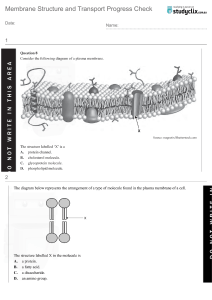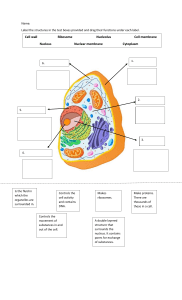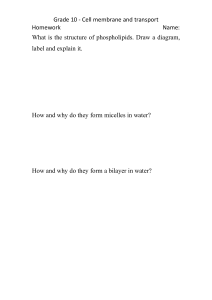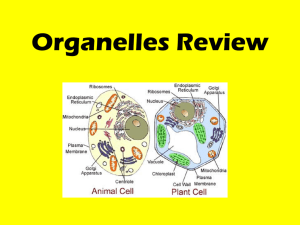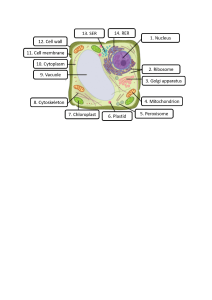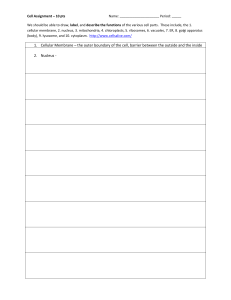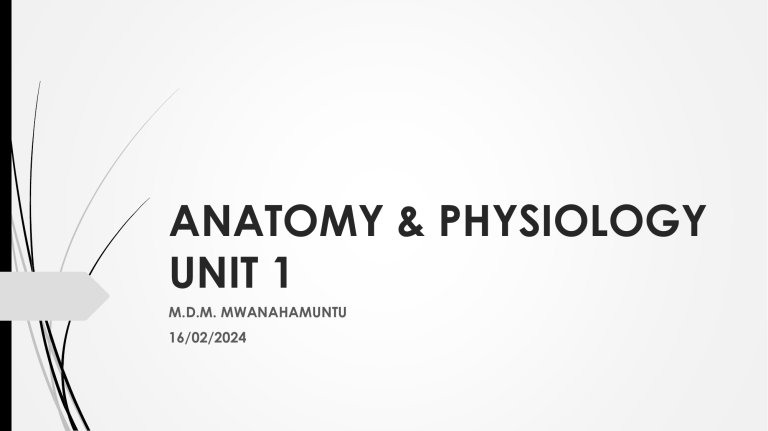
ANATOMY & PHYSIOLOGY UNIT 1 M.D.M. MWANAHAMUNTU 16/02/2024 STUDENT LEARNING OBJECTIVES By the end of the lesson, the student must demonstrate understanding of: Definition of terms in Anatomy & Physiology Organization of the body Systems and body design Cavities and contents Structures, types and functions Cells Tissues Organs State the body s Homeostasis Body fluids OBJECTIVES CONTD.. - Fluids in relation to body weight - Fluid compartments - Fluid balance (fluid gain and loss) Electrolytes - Distribution of various electrolytes and body fluids - Acid base balance - Acidosis and alkalosis Explain Hormonal control - Fluids and electrolytes - Internal organs DEFINITION OF TERMS USED IN ANATOMY AND PHYSIOLOGY Cells: cells are the smallest functional units of the body (Wilson & Waugh, 1996). They are grouped together to form tissues. Tissues: body tissue consists of a large numbers of cells and is classified according to the size, shape and functions of the cells (Wilson & Waugh, 1996). Membrane: these are sheets of epithelial tissue that cover or line internal structures or cavities (Wilson & Waugh, 1996). Organ: this is a group of body tissue organized together to perform a particular CONTD System: this is a group of organs grouped together to perform a particular function which maintains the bodys metabolism and homeostasis. The anatomical position: this is the position of the body when it is in an upright position with the head facing forward, the arms at the sides with palms of the hand facing forward, and the feet together (Wilson & Waugh, 1996). It is assumed in all anatomical descriptions to ensure accuracy and consistency. Median plane: this describes an anatomical position, whereby the body is divided longitudinally into right and left halves Medial and lateral: medial refers to any structure which nearer the midline of the body. For example, the nose is medial to the eyes. CONTD.. Lateral refers to any structure that is far from the midline or at the side of the body. For example, the eyes are lateral to the nose Proximal and Distal: These terms are used when describing the bones of the limbs. The proximal end of the bone is the one nearest to the point of attachment of the limb, while the distal end is further away from the point of attachment of the limb. Anterior or ventral: This indicates that the part being described is nearer to the front of the body. Posterior or Dorsal: This means that the part being described is nearer to the back of the body. CONTD.. Superior: This indicates a structure nearer to the head. Inferior: This indicates a structure farther away from the head. Border: This is a ridge of bone which separates two surfaces. Spine, spinous process or crest: This is a sharp ridge of bone Styloid process: This is a sharp downward projection of bone which gives attachment to muscles. Fossa: this is a depression or hollow Foramen: this is a hole or opening in the any structure of the body Bony sinus: this is a hollow cavity within a bone Meatus: this is a tube-shaped cavity within a bone. CONTD.. Articulation: this is a joint between two or more bones. name given to an immovable joint. Suture: this is the Articulating surface: this is the part of the bone which enters into the formation of a joint. Facet: this is a small, generally rather flat, articulating surface. Condyle: This is a smooth rounded projection found at the end of a bone which is part of a joint. Septum: this is a partition separating two cavities. Fissure or cleft: this is a narrow slit. ORGANIZATION OF THE BODY The human body consists of trillions of atoms arranged in specific ways and thousands of chemical reactions that proceed in a very orderly manner. The human body is organized in different structural levels of increasing complexity. Each higher level incorporates the structures and functions of the previous level. It starts at the lowest level with atoms, molecules and compounds and then proceed to form the cells, tissues, organs, and systems. (Scanlon and Sanders, 2006). BODY SYSTEMS AND DESIGN A system is an organization of varying numbers and kinds of organs which together perform complex functions for the body. There are 10 major systems in the human body. These are: Skeletal system Muscular system Nervous system Endocrine system Cardiovascular system Lymphatic system CONTD.. Respiratory system Digestive system Urinary system Reproductive system Cavities of the Body The organs that make up the systems of the body are contained in four cavities. These are: Cranial cavity Thoracic cavity Abdominal cavity Pelvic cavity Medicine LibreTexts, 2023 CONTD.. Cranial Cavity The cranial cavity contains the brain and its boundaries are formed by the bones of the skull. These are: Anteriorly —1 frontal bone Laterally — 2 temporal bones Posteriorly — 1occipital bone Superiorly — 2 parietal bones Inferiorly — 1 sphenoid and 1ethmoid bone and parts of the frontal, temporal and occipital bones. CONTD.. Thoracic cavity This cavity is situated in the upper part of the trunk. It’s boundaries are formed by the following bony framework and supporting muscles: Anteriorly — the sternum and costal cartilages of the ribs Laterally — 12 pairs of ribs and the intercostal muscles Posteriorly — the thoracic vertebrae and the intervertebral discs between the bodies of the vertebrae Superiorly — the structures forming the root of the neck Inferiorly — the diaphragm, a dome-shaped muscle CONTD.. Organs And Structures Of The Thoracic Cavity The main organs and structures contained in the thoracic cavity are: The trachea, 2 bronchi, 2 lungs; The heart, aorta, superior and inferior vena cava, numerous other blood vessels; The oesophagus. Abdominal Cavity This is the largest cavity in the body and is oval in shape. It is situated in the main part of the trunk and its boundaries are: Superiorly — the diaphragm, which separates it from the thoracic cavity CONTD.. Anteriorly — the muscles forming the anterior abdominal wall Posteriorly —the lumbar vertebrae and muscles forming the posterior abdominal wall Laterally — the lower ribs and parts of the muscles of the abdominal wall Inferiorly — the pelvic cavity with which it is continuous. As a rule, the abdominal cavity is divided into nine regions. This facilitates the description of the positions of the organs and structures in the cavity.. Organs and structures of the abdominal cavity Most of the space in the abdominal cavity is occupied by the organs and glands involved in the digestion and absorption of food. These are: The stomach, small intestine and most of the large intestine The liver, gall bladder, bile ducts and pancreas. Biology Dictionary CONTD.. Pelvic Cavity The pelvic cavity is roughly funnel shaped and extends from the lower end of the abdominal cavity. The boundaries are: Superiorly — it is continuous with the abdominal cavity Anteriorly — the pubic bones Posteriorly — the sacrum and coccyx Laterally — the innominate bones Inferiorly — the muscles of the pelvic floor CONTD.. Organs and structures of the pelvic cavity The pelvic cavity contains the following organs and structures: Sigmoid colon, rectum and anus; Some loops of the small intestine; Urinary bladder, lower parts of the ureters and the Urethra; In the female, the organs of the reproductive system: the uterus, uterine tubes, ovaries and vagina; In the male, some of the organs of the reproductive system: the prostate gland, seminal vesicles, spermatic cords, deferent ducts (vas deferens), ejaculatory ducts and the urethra (common to the reproductive and urinary systems) (Scanlon and Sanders, 2006.) STRUCTURAL LEVELS OF THE HUMAN BODY The body is organized in the following structural levels: Cells Tissues Organs Systems and Body Designs THE CELL All living organisms are made of cells and cell products. Cells are the smallest living units of the human body. The human body develops from a single cell known as the zygote. It results from the fusion of the ovum (female egg cell) and the spermatozoon (male germ cell). Cell multiplication follows and as the foetus grows, cells with different structural and functional specialisations develop with the same genetic make-up as the zygote. Individual cells are too small to be seen with the naked eye. However, they can be seen when thin slices of tissue are stained in the laboratory and magnified by a microscope. CELL STRUCTURE AND FUNCTION A human cell has several distinct structural features. A cell consists of a plasma membrane inside which there are a number of organelles floating in a watery fluid called cytosol. Organelles are small structures with highly specialised functions, many of which are contained within a membrane. They include: The nucleus, Mitochondria, Ribosomes, Endoplasmic reticulum, Golgi apparatus, Lysosomes, Microfilaments, and Microtubules. PLASMA MEMBRANE Every cell in the body is enclosed by a cell (Plasma) membrane. The cell membrane separates the material outside the cell, extracellular, from the material inside the cell, intracellular. It maintains the integrity of a cell and controls passage of materials into and out of the cell (semi-permeable). All materials within a cell must have access to the cell membrane (the cell's boundary) for the needed exchange. The plasma membrane consists of two layers of phospholipids (fatty substances with some protein molecules embedded in them. Those that extend all the way through the membrane may provide channels that allow the passage of, for example, electrolytes and non-lipid-soluble substances. CONTD.. The phospholipid molecules have a head which is electrically charged and hydrophilic (meaning 'water loving') and a tail which has no charge and is hydrophobic (meaning 'water hating'). The phospholipid bilayer is arranged like a sandwich with the hydrophilic heads aligned on the outer surfaces of the membrane. The cell membrane is a double layer of phosphor-lipid molecules. Proteins in the cell membrane provide structural support, form channels for passage of materials, act as receptor sites, function as carrier molecules, and provide identification markers. CONTD.. The plasma membrane consists mainly of phospholipids and proteins, most of the membrane proteins being glycol-proteins. The two components of the phospholipids are the heads and the fatty acid tails (that extend into the phosphor-lipid bilayer). The exterior of the plasma membrane touches water i.e. polar heads (hydrophilic) touch water on the inside of the cell and water on the outside of the cell. Water and other molecules cannot pass through to either side because of the non-polar tails (hydrophobic). The cell membrane provides a stabilized environment, which protects and maintains the cell’s internal environment, separate from the environment outside. Proteins embedded into the membrane send and receive signals to communicate with other cells Other molecules present in the plasma membrane generally include cholesterol and glycol-lipids. CONTD.. Nucleus and Nucleolus The nucleus, formed by a nuclear membrane around a fluid nucleoplasm, is the control centre of the cell. Threads of chromatin in the nucleus contain deoxyribonucleic acid (DNA), the genetic material of the cell in form of genes and also information for the formation of proteins. Information is carried on chromosomes, which are a form of DNA. The nucleolus is a dense region of ribonucleic acid (RNA) in the nucleus and is the site of ribosome formation. The nucleus determines how the cell will function, as well as the basic structure of that cell. CONTD.. Cytoplasm The cytoplasm is the gel-like fluid inside the cell. It is the medium for chemical reaction. It provides a platform upon which other organelles can operate within the cell. All of the functions for cell expansion, growth and replication are carried out in the cytoplasm of a cell. Within the cytoplasm, materials move by diffusion, a physical process that can work only for short distances. Cytoplasmic organelles Cytoplasmic organelles are "little organs" that are suspended in the cytoplasm of the cell. Each type of organelle has a definite structure and a specific role in the function of the cell. Examples of cytoplasmic organelles are mitochondrion, ribosomes, endoplasmic reticulum, Golgiapparatus, and lysosomes. CONTD.. Nucleus: The nucleus contains a nucleolus and is separated from the cytoplasm by the nuclear envelope The nucleus contains the cell’s DNA, a type of nucleic acid. The nucleolus is like a “tiny nucleus” inside the actual nucleus. It contains RNA, a type of nucleic acid. The nucleus communicates through holes in the envelope called nuclear pores. The nucleus decides what the cell needs and uses DNA to print out instructions for the rest of the cell to meet that need. CONTD.. Endoplasmic Reticulum (ER) The endoplasmic reticulum (ER) is an extensive network of membranous tubules that extend from the nuclear membrane to the cell membrane. The rough ER has numerous ribosomes on its surface, whereas the smooth ER has no ribosomes. As a network of interconnected tunnels, the ER is a passageway for the transport of the materials necessary for cell function within the cell. These include proteins synthesized by the ribosomes on the rough ER, and lipids synthesized by the smooth ER. Ribosomes Ribosomes are very small structures made of protein and ribosomal RNA. Some are found on the surface of rough ER, while others float freely within the cytoplasm. Ribosomes are the CONTD.. protein builders or protein synthesizers of the cell. The proteins they produce may be structural proteins such as collagen in the skin, enzymes, or hormones such as insulin that regulate cellular processes. These proteins may function within the cell or be secreted from the cell to be used elsewhere in the body. Our protein molecules are subject to damage, and some cellular proteins, especially regulatory proteins, may be needed just for a very short time. All such proteins must be destroyed, and this is the function of proteasomes. Proteasome A proteasome is a barrel-shaped organelle made of enzymes that cut protein molecules apart (protease enzymes). Proteins that need to be destroyed, that is, those no longer needed or those that are damaged or misfolded, are tagged by a protein called ubiquitin (sort of a cellular mop or broom) and carried into a proteasome. CONTD.. Golgi apparatus These are a series of flat, membranous sacs, somewhat like a stack of saucers. Carbohydrates are synthesized within the Golgi apparatus, and are packaged, along with other materials, for secretion from the cell. Proteins from the ribosomes or lipids from the smooth endoplasmic reticulum may also be secreted in this way. To secrete a substance, small sacs of the Golgi membrane break off and fuse with the cell membrane, releasing the substance to the exterior of the cell. The process by which cells excrete waste products is known as exocytosis. Exo means “to go out” of the cell. Mitochondria Mitochondria are oval or spherical organelles bounded by a double membrane. The inner membrane has folds called cristae. Within the mitochondria, the aerobic (oxygen-requiring) reactions of cell respiration take place. They are described as "the powerhouse of the cell" because they generate most of the cell's supply of adenosine triphosphate (ATP), used as a source of chemical energy. Cells that require large amounts of ATP, such as muscle cells, have many mitochondria to meet their need for energy CONTD.. Lysosomes These are single-membrane structures that contain digestive enzymes. When certain white blood cells engulf bacteria, the bacteria are digested and destroyed by these lysosomal enzymes. This enzymes also digest worn-out cell parts and dead cells. This is a beneficial process, and is necessary before tissue repair can begin. But it does have a disadvantage in that, lysosomal digestion contributes to inflammation in damaged tissues. An excess of inflammation can start a vicious cycle, that results in extensive tissue damage. Centrioles They are a pair of rod shaped structures perpendicular to one another, located just outside the nucleus. Their function is to organize the spindle fibres during cell division. The spindle fibres are contracting proteins that pull the two sets of chromosomes apart, toward the ends of the original cell as it divides into two new cells. Each new cell then has a full set of chromosomes. CONTD.. Cilia and flagella These are mobile thread-like projections through the cell membrane. Each is anchored by a basal body just within the membrane. Cilia are usually shorter than flagella, and an individual cell has many of them on its free surface. The cilia of a cell beat in unison and sweep materials across the cell surface. For example, cells lining the fallopian tubes have cilia to sweep the egg cell toward the uterus. The only human cell with a flagellum is the sperm cell. The flagellum provides motility, or movement, for the sperm cell. Microvilli These are folds of the cell membrane on the free surface of a cell. These folds greatly increase the surface area of the membrane. They are also part of the cells which line organs that absorb materials. The small intestines, for example, require a large surface area for the absorption of nutrients and many of its lining cells have microvilli. Also some cells of the kidney tubules have microvilli that provide for the efficient reabsorption of useful materials back to the blood ASSIGNMENT Identify the different parts in a cell and explain the functions.
